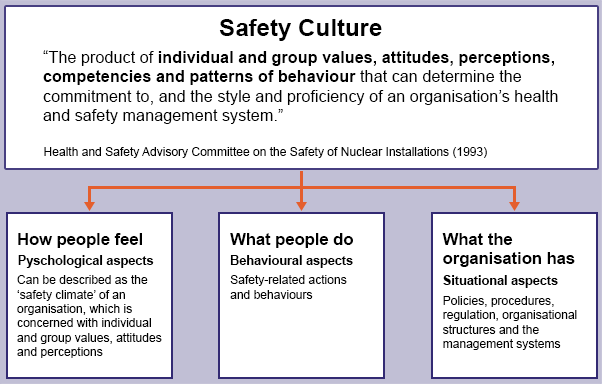Safety Culture
"The way we do things around here"
A positive safety culture is characterised by a tendency to act safely at work, leaning towards doing things the safer way. Making decisions and taking actions with health and safety as the priority, consistently, clearly. No matter what.
Safety culture at work matters and will impact individuals, teams and organisational health and safety performance, and therefore business outcomes and productivity.
Every organisation has its’ own safety culture. It is how these beliefs and assumptions manifest in everyday worker practices to act safely or unsafely that is important. In an organisation with a positive health and safety culture everyone puts health and safety high on the list.

(based on Health and Safety Executive, 2005; Cooper, 2000)
Safety culture, often described as "the way we do things around here" (CBI, 1990) is dependent on three aspects:
- How people feel (psychological aspects): individual and group values and attitudes towards safety;
- What people do (behavioural aspects): safety-related actions and behaviours;
- What the organisation has (situational aspects): the health and safety policies, procedures and management structures in place.
There can be a tendency to see safety culture as something that is ‘wrong’ with the workforce However repeated studies show that management commitment and management style is significant. In particular, the development of a positive safety culture is dependent on visible senior management commitment to safety and consistent messages that safety is a priority demonstrated in management decisions and actions.
A positive safety culture is influenced by
- Management commitment and style;
- Worker involvement;
- Communications;
- Organisational learning;
- Training and competence;
- Usability of procedures
References and Resources
- Advisory Committee on the Safety of Nuclear Installations (1993) Human Factors Study Group Third Report: Organising for Safety. London: HMSO.
- Confederation of British Industry (1990) Developing a Safety Culture- Business for Safety. London.
- Cooper, M.D., 2000. Towards a Model of Safety Culture. Safety Science, 36, 111-136
- Energy Institute (2024) What is safety culture?
- EU OSHA (2011) Occupational Safety and Health Cultural Assessment – A review of main approaches and selected tools.
- Health and Safety Executive (2024) Organisational Culture: Why is organisational culture important?
- Health Service Executive (2024) Just Culture
- Skybrary Aviation (2024) Safety Culture
-
PepsiCo Case Study: Driving a change in culture by viewing ‘safety differently’
